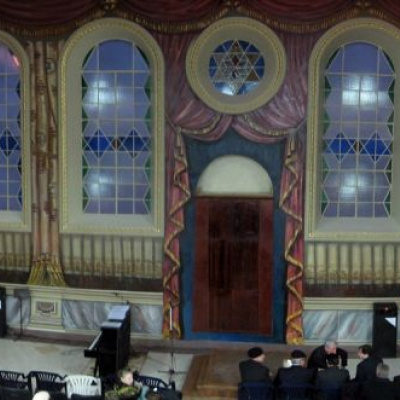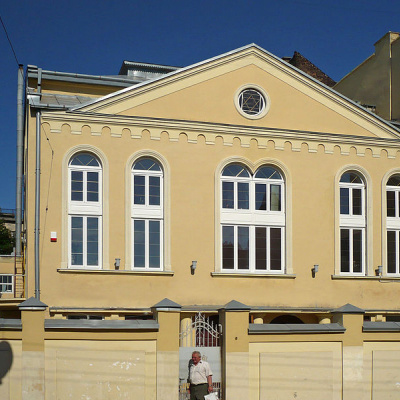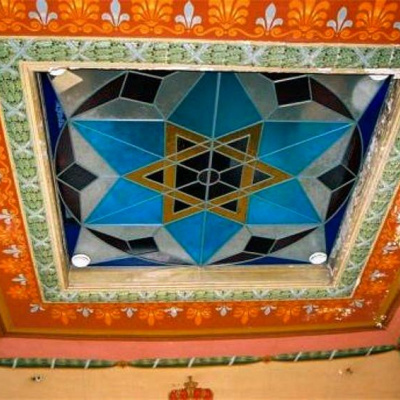Synagogue Beis Aharon ve Israel (Tzori Gilod), Lviv
Tzori Gilod is a functioning synagogue in Lviv on Bratykh Mikhnovskikh Street, not far from the railway station. It was returned to the Jewish community of Lviv in 1989, but the new religious community, representatives of the Karlin Hasidic movement, began to call the synagogue Beis Aharon ve Yisroel (House of Aharon and Israel) to emphasize the synagogue's affiliation with their institutions, but for Lviv residents it remains known by its historical name, Tzori Gilod. A visit to the ancient operating synagogue Beis Aharon ve Israel should definitely be included in the tourist program during your stay in Lviv.
This Jewish shrine is a real work of art with magnificent chandeliers, stained glass windows of the Star of David, polychrome paintings, large windows and secessionist decor. The Beis Aharon ve Yisrael synagogue seats 384 people, and there are also two galleries for women. The synagogue was recently renovated. The Beis Aharon ve Israel synagogue is one of the most memorable historical shrines in Lviv, which residents and visitors of the city visit with pleasure. It has many interesting features and architectural details that are definitely worth seeing.
In 1897, Moses Griffel built a one-story parterre house on a plot between Michnovski and Khotynska streets. In 1912, it was purchased by the Tzori Gilod ("Healing Balm") society, founded in 1899 by Rabbi Joachim Gutman. Thesocietytook care of orphans and the elderly, as well as the families of its deceased members. According to the magistrate's permission, the society adapted the house into a prayer hall with a men's (9.65 x 10.2 m) and a women's (9.65 x 4.0 m) room. After receiving permission from the magistrate, in 1923-1925 the society built a new synagogue designed by Albert Kornbluth. The prayer hall (14.2×14 meters) had 384 seats.
The Tzori Gild synagogue was not affected by the war destruction; during the Soviet occupation it was used as a warehouse, and in 1989 it was returned to the Lviv Jewish community Beis Aharon ve Israel. In 1990-1991, the building was renovated under the leadership of the Israeli rabbi Awrum Rozental. A room was fenced off on the second tier of galleries, a part of the first tier of galleries at the southern and northern walls was covered with gypsum slabs, and the rabbi's office and study were arranged. Storage and utility rooms were arranged on the parterre, on the site of the central aisle, and a kitchen and dining room, as well as a dormitory for yeshiva students, were added to the north wall.
Today the Tzori Gild synagogue stands in the neighborhood; its eastern façade faces Khotynska street, and its main, western façade faces Mikhnovskich street, with a small courtyard enclosed by a wall and gate. Both facades are representative and feature large semicircular windows. The east façade is accentuated by a large round window with the Star of David on its axis above the Torah niche. An arcade of fourteen semicircular arches in the upper part of the façade resembles an attic, which was a defining feature of ancient synagogue architecture. The interior design has discrepancies with the project: two tiers of circling galleries with parapets are absent from Albert Kornbluth's 1923 design proposals.
The prayer hall originally had a skylight in the center of a false (wooden) vault decorated with a stained-glass window with the Star of David. Due to lack of funds for restoration, in 1990 the lantern was covered with boards. Fragments of the stained glass windows have been preserved. The walls and vaults of the prayer hall are covered with polychrome paintings. It was created by Maximilian Kugel. The motifs of the paintings are traditional symbolic images of birds (storks, swallows) and animals. On the east wall above the Torah niche, two griffins hold the Tablets of the Covenant; on the opposite wall, an open Torah is depicted, wrapped in tallit. Four symbolic animals (a lion, a tiger, a deer, and an eagle) are painted on the vault's hollyhocks. The emblems of the twelve tribes of Israel are traditionally located along the frieze belt. The north and south walls are painted with identical images of musical instruments framed by illusionary architectural decor. The landscape with the tomb of Rachel's foremother, the western wall of the Jerusalem Temple, the interior of Solomon's Temple, and the Tablets of the Covenant above Mount Sinai clearly illustrate the purpose of the building. In the inter-window spaces on the eastern wall there is an image of the Temple Curtain.
The mural of the Tzori Gilded Synagogue is one of the few surviving synagogue murals in Ukraine. Unfortunately, due to unprofessional restoration, the mural of the Tzori Gild synagogue lost the soul invested by the author and the authentic valleys.





